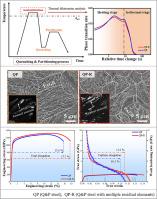Effects of residual elements on the microstructure and mechanical properties of a Q&P steel
IF 14.3
1区 材料科学
Q1 MATERIALS SCIENCE, MULTIDISCIPLINARY
引用次数: 0
Abstract
Producing steel requires large amounts of energy to convert iron ores into steel, which often comes from fossil fuels, leading to carbon emissions and other pollutants. Increasing scrap usage emerges as one of the most effective strategies for addressing these issues. However, typical residual elements (Cu, As, Sn, Sb, Bi, etc.) inherited from scrap could significantly influence the mechanical properties of steel. In this work, we investigate the effects of residual elements on the microstructure evolution and mechanical properties of a quenching and partitioning (Q&P) steel by comparing a commercial QP1180 steel (referred to as QP) to the one containing typical residual elements () (referred to as QP-R). The results demonstrate that in comparison with the QP steel, the residual elements significantly refine the prior austenite grain ( vs. ) due to their strong solute drag effect, leading to a higher volume fraction (13.0% vs. 11.8%), a smaller size (473 nm vs. 790 nm) and a higher average carbon content (1.26 wt% vs. 0.99 wt%) of retained austenite in the QP-R steel. As a result, the QP-R steel exhibits a sustained transformation-induced plasticity (TRIP) effect, leading to an enhanced strain hardening effect and a simultaneous improvement of strength and ductility. Grain boundary segregation of residual elements was not observed at prior austenite grain boundaries in the QP-R steel, primarily due to continuous interface migration during austenitization. This study demonstrates that the residual elements with concentrations comparable to that in scrap result in significant microstructural refinement, causing retained austenite with relatively higher stability and thus offering promising mechanical properties and potential applications.

残余元素对 Q&P 钢微观结构和机械性能的影响
生产钢铁需要大量能源将铁矿石转化为钢材,而这些能源通常来自化石燃料,从而导致碳排放和其他污染物。增加废钢使用量是解决这些问题的最有效策略之一。然而,废钢中的典型残留元素(铜、砷、锡、锑、铋等)会严重影响钢的机械性能。在这项工作中,我们通过比较商用 QP1180 钢(简称 QP)和含有典型残余元素(Cu+As+Sn+Sb+Bi<0.3wt%)的钢(简称 QP-R),研究了残余元素对淬火分型(Q&P)钢的微观结构演变和机械性能的影响。结果表明,与 QP 钢相比,残余元素因其强大的溶质拖曳效应而显著细化了先前的奥氏体晶粒(9.7μm 对 14.6μm),导致 QP-R 钢中残余奥氏体的体积分数更高(13.0% 对 11.8%)、尺寸更小(473 nm 对 790 nm)、平均碳含量更高(1.26 wt% 对 0.99 wt%)。因此,QP-R 钢表现出持续的转变诱导塑性(TRIP)效应,从而增强了应变硬化效应,并同时提高了强度和延展性。在 QP-R 钢中的奥氏体晶界处未观察到残余元素的晶界偏析,这主要是由于奥氏体化过程中持续的界面迁移所致。这项研究表明,残余元素的浓度与废钢中的残余元素浓度相当,可显著改善微观结构,使残余奥氏体具有相对较高的稳定性,从而提供良好的机械性能和潜在的应用前景。
本文章由计算机程序翻译,如有差异,请以英文原文为准。
求助全文
约1分钟内获得全文
求助全文
来源期刊

Journal of Materials Science & Technology
工程技术-材料科学:综合
CiteScore
20.00
自引率
11.00%
发文量
995
审稿时长
13 days
期刊介绍:
Journal of Materials Science & Technology strives to promote global collaboration in the field of materials science and technology. It primarily publishes original research papers, invited review articles, letters, research notes, and summaries of scientific achievements. The journal covers a wide range of materials science and technology topics, including metallic materials, inorganic nonmetallic materials, and composite materials.
 求助内容:
求助内容: 应助结果提醒方式:
应助结果提醒方式:


